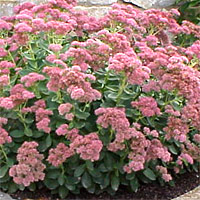Sedum

The succulent foliage of many types of sedum is topped by starry flowers in late summer and fall. Low-growing types are perfect for rock gardens, while taller varieties thrive in perennial borders. Another common name is stonecrop.
About This Plant
There are numerous types of sedum, all of which have fleshy, succulent leaves. Low-growing varieties hug the ground and may reach just 2 inches in height, while tall varieties top out at 2 feet or more. Use the low-growing types as ground covers and in rock gardens; tall varieties command attention in the perennial border with their dense foliage and large flower heads. Flower colors include red, pink, gold, yellow, and white, and plants bloom in summer to fall, depending on the species. Well-drained soil is essential to ward off fungal diseases, especially during wet summers.
Special Features
Easy care/low maintenance
Good for cut flowers
Attracts butterflies
Unusual foliage
Tolerates dry soil
Site Selection
Select a site with full sun to light shade and very well-drained soil.
Planting Instructions
Plant in spring, spacing plants 6 inches to 2 feet apart, depending on the variety. Prepare the garden bed by using a garden fork or tiller to loosen the soil to a depth of 12 to 15 inches, then mix in a 2- to 4-inch layer of compost. Dig a hole twice the diameter of the pot the plant is in. Carefully remove the plant from its container and place it in the hole so the top of the root ball is level with the soil surface. Carefully fill in around the root ball and firm the soil gently. Water thoroughly.
Care
Apply a thin layer of compost each spring, followed by a 2-inch layer of mulch to retain moisture and control weeds. Water plants during the summer if rainfall is less than 1 inch per week. After the first killing frost, cut stems back to an inch or two above soil line. Divide plants every 3 to 4 years as new growth begins in the spring, lifting plants and dividing them into clumps.






 The succulent foliage of many types of sedum is topped by starry flowers in late summer and fall. Low-growing types are perfect for rock gardens, while taller varieties thrive in perennial borders. Another common name is stonecrop.
The succulent foliage of many types of sedum is topped by starry flowers in late summer and fall. Low-growing types are perfect for rock gardens, while taller varieties thrive in perennial borders. Another common name is stonecrop.